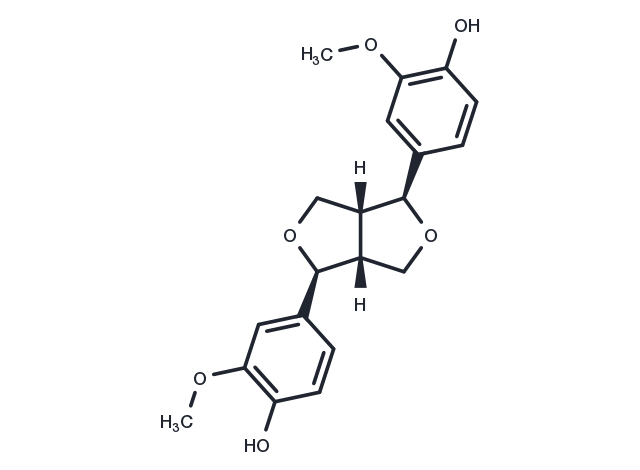Powder: -20°C for 3 years | In solvent: -80°C for 1 year


Pinoresinol ((+)-Pinoresinol) has antiinflammatory, hepatoprotective, and fungicidal activities, it can protect pial microcirculation from I-reperfusion injury, to increase nitric oxide release and to reduce oxidative stress preserving pial blood flow distribution; it may exert pharmacologically interesting effects via modulation of the insulin-like signalling pathway in C.elegans. Pinoresinol causes an upregulation of the CDK inhibitor p21(WAF1/Cip1) both at mRNA and protein levels, inhibits NF-kappaB and activating protein 1 (AP-1).

| Pack Size | Availability | Price/USD | Quantity |
|---|---|---|---|
| 1 mg | In stock | $ 84.00 | |
| 5 mg | In stock | $ 178.00 | |
| 10 mg | In stock | $ 287.00 | |
| 25 mg | In stock | $ 489.00 | |
| 50 mg | In stock | $ 686.00 | |
| 100 mg | In stock | $ 969.00 | |
| 1 mL * 10 mM (in DMSO) | In stock | $ 197.00 |


| Description | Pinoresinol ((+)-Pinoresinol) has antiinflammatory, hepatoprotective, and fungicidal activities, it can protect pial microcirculation from I-reperfusion injury, to increase nitric oxide release and to reduce oxidative stress preserving pial blood flow distribution; it may exert pharmacologically interesting effects via modulation of the insulin-like signalling pathway in C.elegans. Pinoresinol causes an upregulation of the CDK inhibitor p21(WAF1/Cip1) both at mRNA and protein levels, inhibits NF-kappaB and activating protein 1 (AP-1). |
| In vitro | Six lignan standards [secoisolariciresinol diglucoside (SDG), secoisolariciresinol (SECO), Pinoresinol (PINO), lariciresinol, matairesinol (MAT), and hydroxymatairesinol] and their colonic metabolites [enterolactone (ENL) and enterodiol] were studied. First, differentiated cells were exposed to SDG, SECO, PINO, or ENL at increasing concentrations for 4 h, and their cellular contents (before and after deconjugation) were determined by HPLC. Second, in IL-1β-stimulated confluent and/or differentiated cells, lignan effects were tested on different soluble proinflammatory mediators quantified by enzyme immunoassays and on the NF-κB activation pathway by using cells transiently transfected. SECO, PINO, and ENL, but not SDG, were taken up and partly conjugated by cells, which is a saturable conjugation process. PINO was the most efficiently conjugated (75% of total in cells). In inflamed cells, PINO significantly reduced IL-6 by 65% and 30% in confluent and differentiated cells, respectively, and cyclooxygenase (COX)-2-derived prostaglandin E(2) by 62% in confluent cells. In contrast, MAT increased significantly COX-2-derived prostaglandin E(2) in confluent cells. Moreover, PINO dose-dependently decreased IL-6 and macrophage chemoattractant protein-1 secretions and NF-κB activity[1] |
| Source |
| Synonyms | (+)-Pinoresinol |
| Molecular Weight | 358.39 |
| Formula | C20H22O6 |
| CAS No. | 487-36-5 |
Powder: -20°C for 3 years | In solvent: -80°C for 1 year
DMSO: 12 mg/ml (33.48 mM)
You can also refer to dose conversion for different animals. More
bottom
Please see Inhibitor Handling Instructions for more frequently ask questions. Topics include: how to prepare stock solutions, how to store products, and cautions on cell-based assays & animal experiments, etc.
Pinoresinol 487-36-5 Apoptosis Cell Cycle/Checkpoint NF-Κb NF-κB p53 CDK apoptotic sensitizer caterpillar inhibit (+)-Pinoresinol cancer Inhibitor lignol glioblastoma inhibitor
